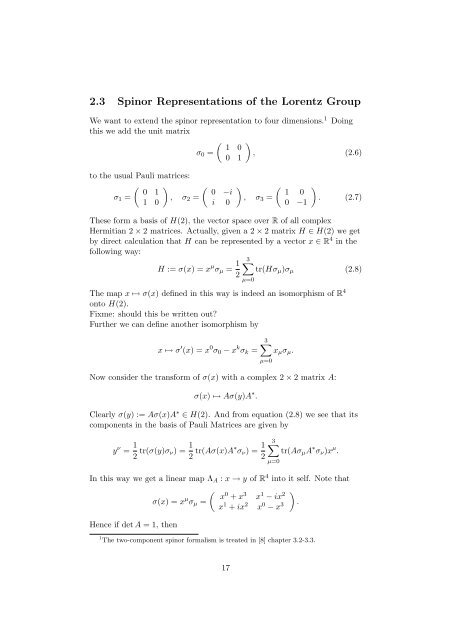Master Dissertation
Master Dissertation
Master Dissertation
You also want an ePaper? Increase the reach of your titles
YUMPU automatically turns print PDFs into web optimized ePapers that Google loves.
2.3 Spinor Representations of the Lorentz Group<br />
We want to extend the spinor representation to four dimensions. 1 Doing<br />
this we add the unit matrix<br />
<br />
1 0<br />
σ0 = , (2.6)<br />
0 1<br />
to the usual Pauli matrices:<br />
σ1 =<br />
0 1<br />
1 0<br />
<br />
, σ2 =<br />
0 −i<br />
i 0<br />
<br />
1 0<br />
, σ3 =<br />
0 −1<br />
<br />
. (2.7)<br />
These form a basis of H(2), the vector space over R of all complex<br />
Hermitian 2 × 2 matrices. Actually, given a 2 × 2 matrix H ∈ H(2) we get<br />
by direct calculation that H can be represented by a vector x ∈ R4 in the<br />
following way:<br />
H := σ(x) = x µ σµ = 1<br />
3<br />
tr(Hσµ)σµ<br />
(2.8)<br />
2<br />
The map x ↦→ σ(x) defined in this way is indeed an isomorphism of R 4<br />
onto H(2).<br />
Fixme: should this be written out?<br />
Further we can define another isomorphism by<br />
µ=0<br />
x ↦→ σ ′ (x) = x 0 σ0 − x k σk =<br />
3<br />
xµσµ.<br />
Now consider the transform of σ(x) with a complex 2 × 2 matrix A:<br />
σ(x) ↦→ Aσ(y)A ∗ .<br />
Clearly σ(y) := Aσ(x)A ∗ ∈ H(2). And from equation (2.8) we see that its<br />
components in the basis of Pauli Matrices are given by<br />
y ν = 1<br />
2 tr(σ(y)σν) = 1<br />
2 tr(Aσ(x)A∗σν) = 1<br />
2<br />
µ=0<br />
3<br />
µ=0<br />
tr(AσµA ∗ σν)x µ .<br />
In this way we get a linear map ΛA : x → y of R 4 into it self. Note that<br />
Hence if det A = 1, then<br />
σ(x) = x µ <br />
x0 + x3 x1 − ix2 σµ =<br />
x 1 + ix 2 x 0 − x 3<br />
<br />
.<br />
1 The two-component spinor formalism is treated in [8] chapter 3.2-3.3.<br />
17



